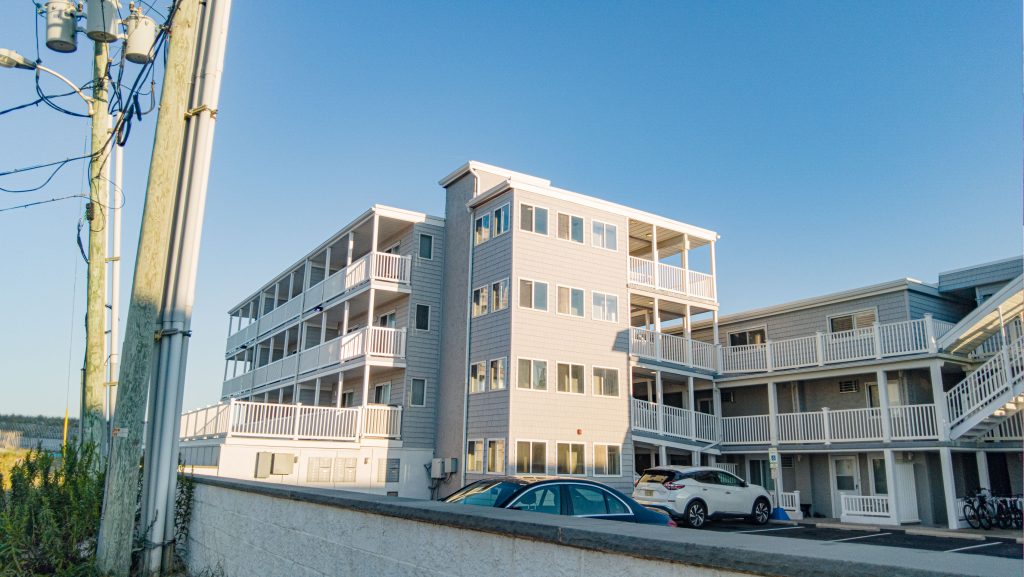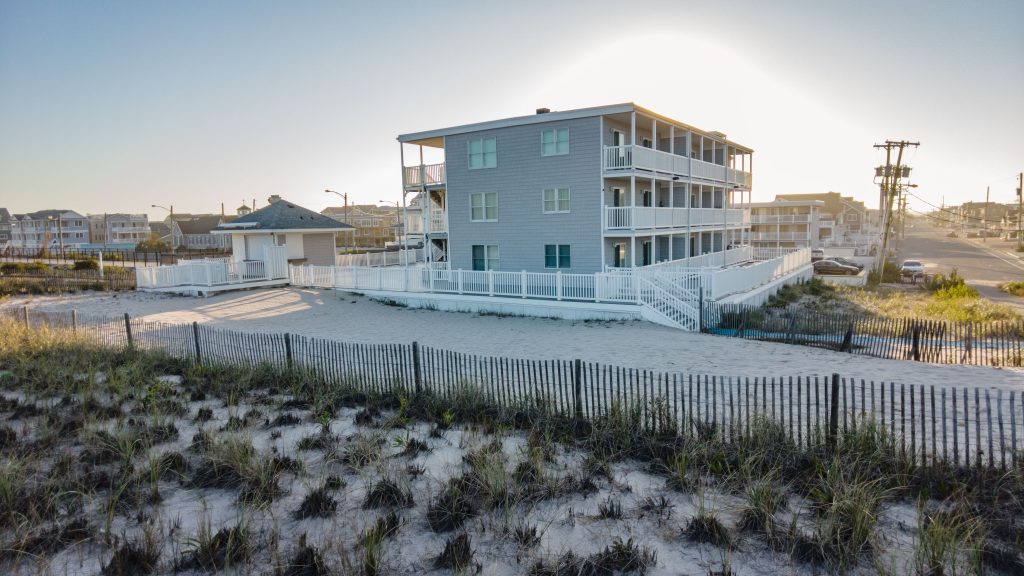
The site of an approved wireless antenna at 1 Second Avenue, Ortley Beach, Oct. 2023. (Photo: Shorebeat)
A “small cell” node containing equipment to boost mobile signal quality to the south and north along local beaches received approval for a location in Ortley Beach Wednesday night.
The Toms River planning board approved the node to be placed on the roof of 1 Second Avenue, an oceanfront property known as the Waldorf Condominiums. The site had previously housed temporary wireless antenna equipment during the summer season, but the growing need for high-speed wireless data necessitated a permanent site in the area, representatives from Verizon, the applicant, told board members Wednesday night.
By the start of this summer season, the planning and engineering work required to place a permanent node on top of the building was not ready, leading Verizon to seek a temporary antenna on top of a mobile monopole placed near the pickleball courts further to the south, angering some residents. Verizon paid the township $20,000 to lease the property. As of Wednesday, the antennas at the pickleball courts had been removed, but portions of the tower and support equipment remained.
“We solved the riddle,” said attorney Richard Schkolnick, representing Verizon. “We’ve been able to enclose the antennas. In 2021 and 2022 we asked for temporary approvals just for the summer use, and now we are able to meet all of the requirements for a permanent site.”
Schkolnick said the site will be located on top of the building and will be located within a “camouflaged enclosure,” but not fully covered. The site will blend in with the color of the building and is planned to be unnoticeable to passersby, since it would resemble an air conditioning or other simple utility unit on top of the complex.
“This is a priority site in town under the wireless ordinance,” said Christopher Nevill, an engineer on the project.
Nevill said under the ordinance, wireless antennas can rise 12 feet above the height of an existing building. In the case of the Second Avenue property, that would equate to 47 feet, however the proposed node was 51-feet above the ground, necessitating a height variance. Because the variation was less than 10 percent higher than allowed by the ordinance, a routine “bulk” variance was required instead of a “use,” or “D” variance, which requires more stringent legal requirements and a supermajority vote by a land use board.

The site of an approved wireless antenna at 1 Second Avenue, Ortley Beach, Oct. 2023. (Photo: Shorebeat)
Unlike wireless small cell nodes that have been placed on top of utility poles in some communities, both 4G and 5G antennas will be placed inside the single unit on top of the building. In the case of pole-based nodes, 4G and 5G equipment are stored in separate boxes, leading some to criticize their aesthetics.
“All of the cabinets are in the structure,” said Nevill. “There have been similar structures on churches and bell towers. It’s not much different than that, except many have been much bigger than this. It has the look of an air conditioning-type system on the top.”
Though there were no formal objectors, one resident of the building asked Verizon about radiofrequency emissions that would originate from the system. Frank Colasurdo, one of the licensed planners who worked on the project, testified that the signal would not be aimed downward toward the building.
“The vast majority of the energy is pointed toward the horizon,” he said. “We want to cover the beaches, so the signal is propagated out toward the beaches.”
Unlike the temporary rig that had been set up at the building in the past, there will be no equipment located at or near ground-level, or on any other part of the property. All of the equipment will be fully contained in the roof-mounted box, which can only accessed from inside the complex, through a roof hatch, and inside the locked facility. A ladder would allow a technician to access the site for maintenance, Colasurdo said, and at the suggestion of the board, pledged to place a pop-out fiberglass ladder there instead of a metal ladder, which would be subject to rust in the marine environment.
Colasurdo said the site is rated to withstand 125 m.p.h. winds, higher than those experienced during Superstorm Sandy. He also said he would arrange for a third party company to visit the concerned resident’s condominium, at her request, and measure radiofrequency emissions to prove they fell within federal safety standards.
“We think this is the best design, considering everything,” said Schkolnick. “We do have challenges along the beach, and the ordinance does encourage camouflaging which is what we proposed.”
Schkolnick acknowledged the lack of popularity among residents of the monopole that was temporarily placed near the pickleball courts this summer. It will not return next year since the permanent site will be active by then. Verizon, he said, may eventually propose an additional permanent site further up Route 35 in the Ocean Beach section, where another temporary tower has been placed seasonally at a marine supply store.

Advertisement

Seaside Heights & Seaside Park
Seaside Heights School Board Seeking More Participation, Will Change Meeting Times

Police, Fire & Courts
Seaside Park Man, 68, Charged in Fatal Crash With Pedestrian

Ortley Beach & North Beaches
Lottery Ticket Worth $10K Sold at Ortley Beach Acme

Ortley Beach & North Beaches
Abandoned Private Island ‘Mansion’ in Barnegat Bay Poised for Demolition







